Welcome to this step-by-step tutorial for PictureEcho where we will keep it all simple and relevant for your ease. This guide will serve as a basic tutorial to help the users develop an understanding of how to use the software. Let’s begin.
Table of Contents
- Select Folders
(a) Adding Local Folders to the Scan
(b) Adding Cloud Folders to the Scan
(c) Removing Folders from the Scan - Select the Scan Type
(a) What are Similarity Settings?
(b) Exact Match
(c) Similar Match - Scan & Review Duplicate/ Similar Images
(a) Starting the Scan
(b) Scan Progress
(b) Previewing the Duplicate Images
(b) Opening an Image, Containing Folder & Properties Dialog - Select Duplicate/ Similar Images
(a) Manually Selecting Individual Images
(b) Automatically Selecting Duplicates Using Selection Patterns
(b) Selecting Images by Location - Choose an Action
(a) Permanent Delete
(b) Move to Folder - Scan Adobe Lightroom Duplicates
(a) Scan Procedure
(b) Important
1. Select Folders
1.1 Adding Local Folders to the Scan
The following steps illustrate how to add local folders to the scan. You can add multiple folders from the hard disk and any other removable storage (such as an External Hard Disk, or a USB Stick) that is connected to your computer.
-
- Click the Add Path icon.
- Select your desired folder, and then click OK.

1.2 Adding Cloud Folders to the Scan
You can also use PictureEcho to scan cloud data to remove any duplicate/ similar images you want to get rid of. Simply sync the data to your computer and then add the local folder to PictureEcho scan just like you would scan a local folder.
1.3 Removing Folders from the Scan
If you have mistakenly added a folder you didn’t want to scan, follow these steps to remove it:
-
- Select the folder you do not want to be scanned.

- Simply click the Remove Path icon.
- Select the folder you do not want to be scanned.
2. Select the Scan Type
2.1 What are Similarity Settings?
Similarity Settings allow you to determine which type of scan you want PictureEcho to launch. You can choose between Exact Match and Similar Match.

2.2 Exact Match
This scan will search for images that are 100% identical to each other.
2.3 Similar Match
This scan searches for images that are visually similar in nature. This option is preferable if you are looking to clean up maximum storage space.
You can further configure this scan by clicking the Similarity Settings link and choosing a scan level of your choice. Click OK to confirm.
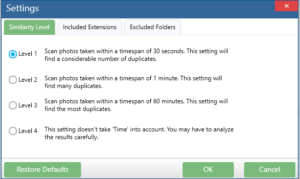
3. Scan & Review Duplicate/ Similar Images
Now that you have configured the scan target area and Similarity Settings, you can launch the scan and review the scan results.
3.1 Starting the Scan
Click the Start Search button and the scan will be instantly launched.
3.2 Scan Progress
When you start the scan, a progress window will appear on your screen displaying the scan progress.
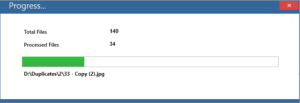
3.3 Previewing the Duplicate Images
You can preview any duplicate images within the PictureEcho interface.
-
- Simply select the Show Preview checkbox (right under the Start Search button) to turn this feature on.

- Now simply click an image and PictureEcho will display the image preview on the right hand side panel.
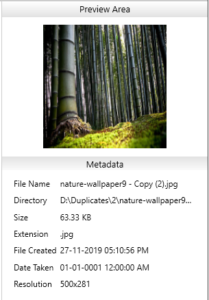
- Simply select the Show Preview checkbox (right under the Start Search button) to turn this feature on.
3.4 Opening an Image, Containing Folder & Properties Dialog
Opening an Image
Right-click an image you want to open, and select the Open option.
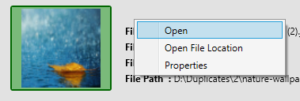
Opening the Containing Folder
To open the parent folder that contains the image, right-click the image and select the Open File Location option.
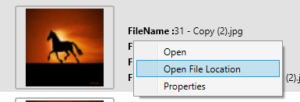
Opening the File Properties Dialog
You can open the Properties dialog to view additional metadata information about an image such as the default program that loads the image, height-width, pixels, image resolution, date taken, and author.
To open the Properties, right-click an image and select Properties.
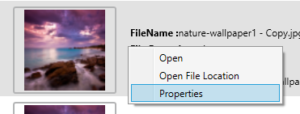
4. Select Duplicate Images
4.1 Manually Selecting Individual Images
PictureEcho displays a comprehensive list of all the duplicate images that are found. Use the checkbox corresponding to an image to mark or unmark it.
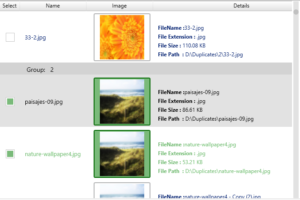
Marked Images
Images that you mark by clicking the checkbox for them will be selected for the action you choose to perform in the next step.
Unmarked Images
These images aren’t select for further action and will be retained in their original location.
4.2 Automatically Selecting Duplicates Using Selection Patterns
The easiest method is to batch select duplicate files using the selection patterns that are available. This will fast track the entire procedure and save you the effort of selecting the individual images manually.
-
- Click the Select Duplicates button.
- Choose one option from the following options to select images based on their size (smaller/ bigger), image resolution (lower/ higher), date of creation (newest/ oldest), or the image location.
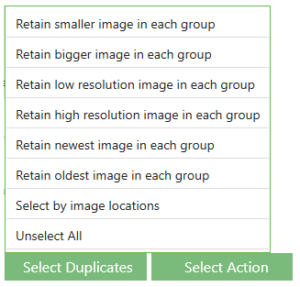
- The Unselect All option will unmark everything and launch the selection process from scratch.
4.3 Selecting Images by Location
You can mark or unmark images that are located in certain folder(s) using the following procedure:
-
- Click the Select Duplicates button and then hit the Select by image locations option.
- Now click the Add button.
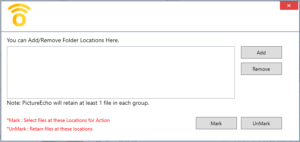
- Type the folder path or click Browse to select your preferred folder.
- To include the contents of the specified folder, select the Include subfolders checkbox.

- Click Add.
- In the subsequent screen, you’ll be able to see the added folder. You can click Add and repeat the same procedure to add multiple folders.
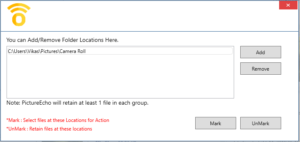
- Use the Mark button to Mark (select their contents for further action) the listed folders, and use the Unmark button to retain their contents.

5. Choose an Action
PictureEcho allows you to choose what you would like to do with the marked files. Clicking the Select Action button will display the following options:

5.1 Permanent Delete
Selecting this option will permanently delete all the selected files. PictureEcho will display a confirmation dialog on your screen. Click Yes to proceed.
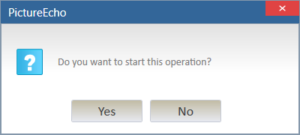
5.2 Move to Folder
You can also move the selected duplicate photos to a folder of your choice. You can easily review these photos in the future.
After selecting this option, you will be prompted to confirm your action. Click Yes.

Now select the destination folder, and click OK to confirm your selection.
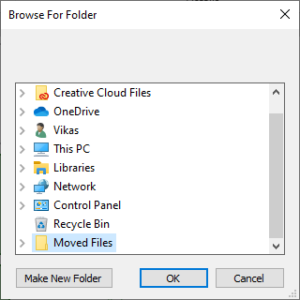
6. Scan Adobe Lightroom for Duplicates
PictureEcho is compatible with Adobe Photoshop Lightroom CC 6 and Adobe Lightroom Classic.
6.1 Scan Procedure
Stage 1: Add Photos to Lightroom Library
-
- Open up Adobe Photoshop Lightroom.
- Click the File menu, followed by Import Photos and Video.
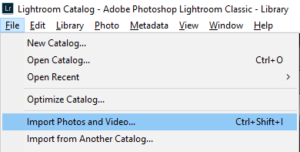
- Select the source directory from the left-hand side panel.
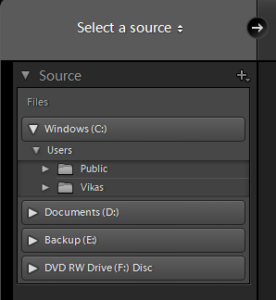
- Select all images you want to add and click Import. This process might take a while.
Stage 2: Scan Your Lightroom Catalog
-
- Open PictureEcho and select the Adobe Lightroom scan mode.
- Select your desired scan type and hit Start Search.

- If Adobe Lightroom is already open, PictureEcho will prompt you to close it first. Click Yes to confirm.
- The scan will be launched as soon as Lightroom is closed.
6.2 Important
PictureEcho may display an error if Lightroom isn’t installed on your system or an incompatible version is detected.
Please download the correct version from the Adobe website and install the program on your computer. Exit and relaunch PictureEcho for the changes to take effect.
We sincerely hope this guide was informative for you. We’ve tried our best to keep it short and to-the-point to avoid any complications. However, if you think we might have missed out on something important or just aren’t sure about any aspect of this software program, you can always shoot us an email at support@pictureecho.com or fill out the form at https://www.pictureecho.com/support